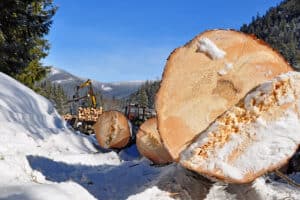As we discussed in Understanding Timber Value: Part I, one key tool for timberland buyers, managers and sellers is having access to reliable, accurate timber data. We learned that having a clear understanding of Capital Timber Value can play a critical role in purchasing, managing, and selling forestland with confidence. We also learned that the two components to estimating Capital Timber Value are (1) determining how much timber volume is growing on the property and (2) calculating how much that timber is worth (its stumpage pricing).
Here we’re going to discuss the first part of this equation – determining how much timber volume is on the property. Timber volumes are collected in the field through a sampling process known as a timber ‘cruise,’ or inventory. During the cruise, enough sample plots are measured throughout the forest to meet the inventory objectives and pass industry standards. Since forests span hundreds or even thousands of acres and include tens of thousands of trees, it’s not cost effective or timely to measure every single tree on the ground. Therefore, a timber inventory is designed to take a cross-sectional, representative sample of the forest’s stocking, density and species mix by collecting enough data to make it statistically reliable for its intended uses.
First, the cruise has to be designed to collect enough data to make it representative – this will be a function of property size, timber stocking and uniformity. Next, foresters go out into the forest, find the pre-determined, random sampling plot locations with a GPS, and collect the data – tree species, diameter, merchantable heights, product calls (boards, veneer, pulp, etc.), tree quality, regeneration, and any other parameters to achieve the intended uses of the inventory data. Once the data is collected in the field, it needs to be processed and reported with the end goal of establishing property-wide volume by species and product across commercially productive acreage.
As a buyer or seller, what you’re looking for in a timber cruise is reliability and accuracy. The four main considerations to weighing the reliability and accuracy of any given timber inventory are as follows:
Inventory Layout – Were enough random plots collected to stand the test of statistical industry standards and meet the inventory objectives? Since an inventory is a sample, it’s important to understand a few things about sampling accuracy and cruise layout. Inventory points are designed to be pre-determined and random. Once the forester determines the number of plots needed for the cruise (typically the goals are valuation or management planning), these plots are then laid out (often on a grid system) using GIS software and uploaded into a GPS unit. Since forests are never entirely uniform, sampling error is common and expected. A reasonable sampling error for a valuation inventory in the Northeast is 10 to 15% +/- at the 95% confidence interval. In simple terms, this means that if an inventory were conducted 100 times, the volumes would fall within 10-15% of the current reported volumes ninety-five times out of one hundred.
Inventory Collection – Was the plot data measured accurately? Are the species, diameters, heights and product calls correct? Did your forestry team conduct an internal ‘check cruise’ or audit to ensure high standards? As a seller, having an experienced forester who understands valuation inventory standards and regional markets is critical. As a buyer, it’s helpful if the field sample plots were ‘monumented’ with a flag and the raw inventory data is available to inspect. You may wish to hire a forester to represent you and conduct a field ‘audit’ to ensure that the appropriate sample points were measured, commercial acreage is correctly represented, and the species, diameters, heights and product calls were collected and recorded accurately.
Cruise Specifications – Are they appropriate for regional markets and current market conditions? Speak with your forester and understand how the product calls were made in the field. Ask questions regarding minimum tree diameters and what quality standards constitute products like veneer logs, saw logs, pallet grade products, and in certain areas, potential sugarbush stems (aka tap trees).
Data Processing and Reporting – Do you have all the necessary information available to make an informed decision? Look for summary reports that highlight volume by species, stocking, quality, and diameter distribution. These can help you project the future growth and revenue cycles of your forest.
As we learned in Part 1 of this series, it will greatly benefit you to understand the nature of timber value. This series offers an explanation on how the data is collected and measured to arrive at the timber value estimate. For sellers, having accurate timber data at their fingertips is an effective, proven means to market one of your property’s greatest attribute. For buyers, it’s a reliable source of information to use in conducting your investment performance analysis. For both parties, it’s a standard from which everyone can negotiate, facilitating the likelihood of a successful transaction.
Written by Todd Waldron, a professional forester and timberland broker with Fountains Land who has served timberland owners and buyers in the northeast since 1996.
This content may not be used or reproduced in any manner whatsoever, in part or in whole, without written permission of LANDTHINK. Use of this content without permission is a violation of federal copyright law. The articles, posts, comments, opinions and information provided by LANDTHINK are for informational and research purposes only and DOES NOT substitute or coincide with the advice of an attorney, accountant, real estate broker or any other licensed real estate professional. LANDTHINK strongly advises visitors and readers to seek their own professional guidance and advice related to buying, investing in or selling real estate.










Add Comment